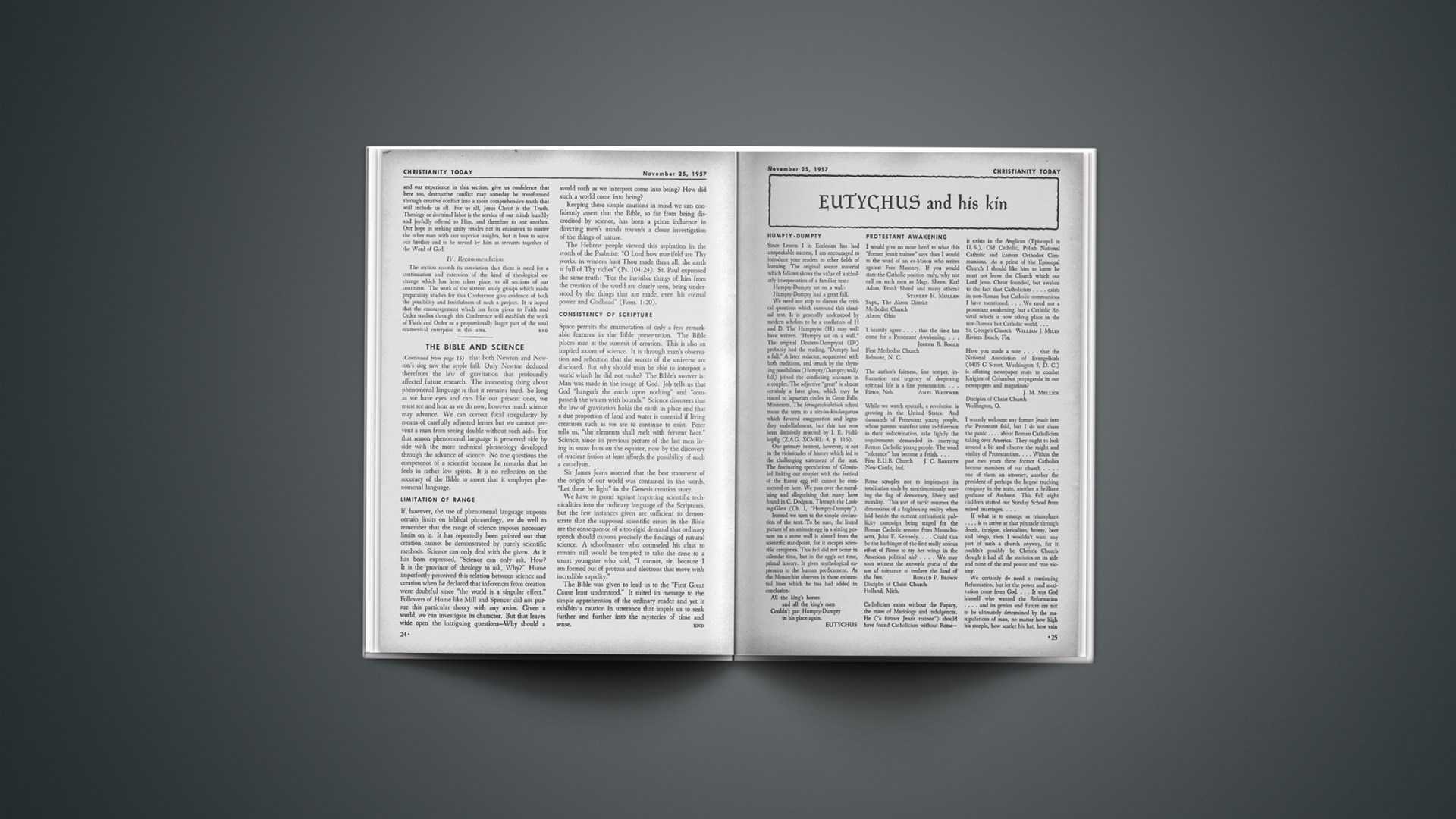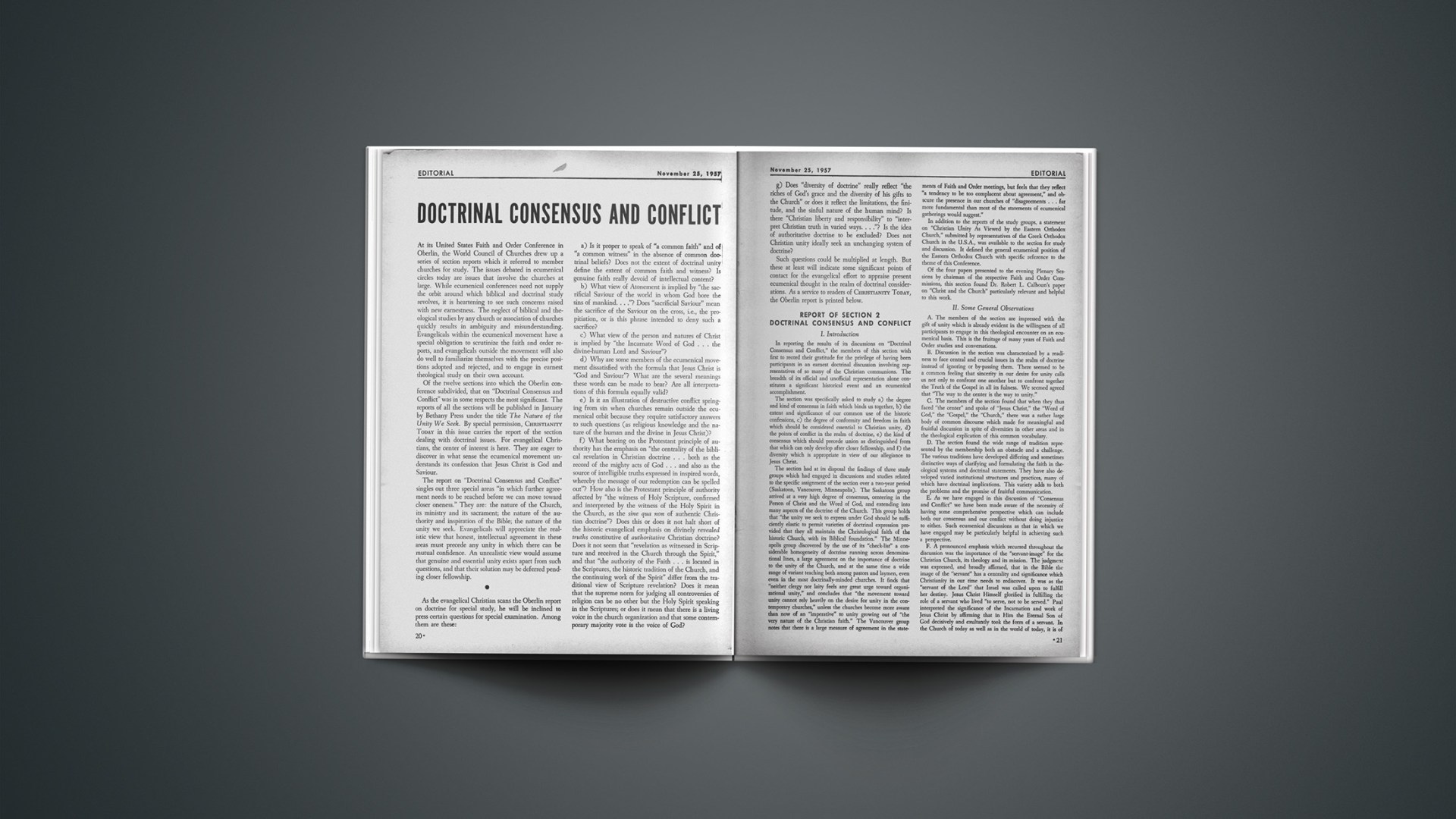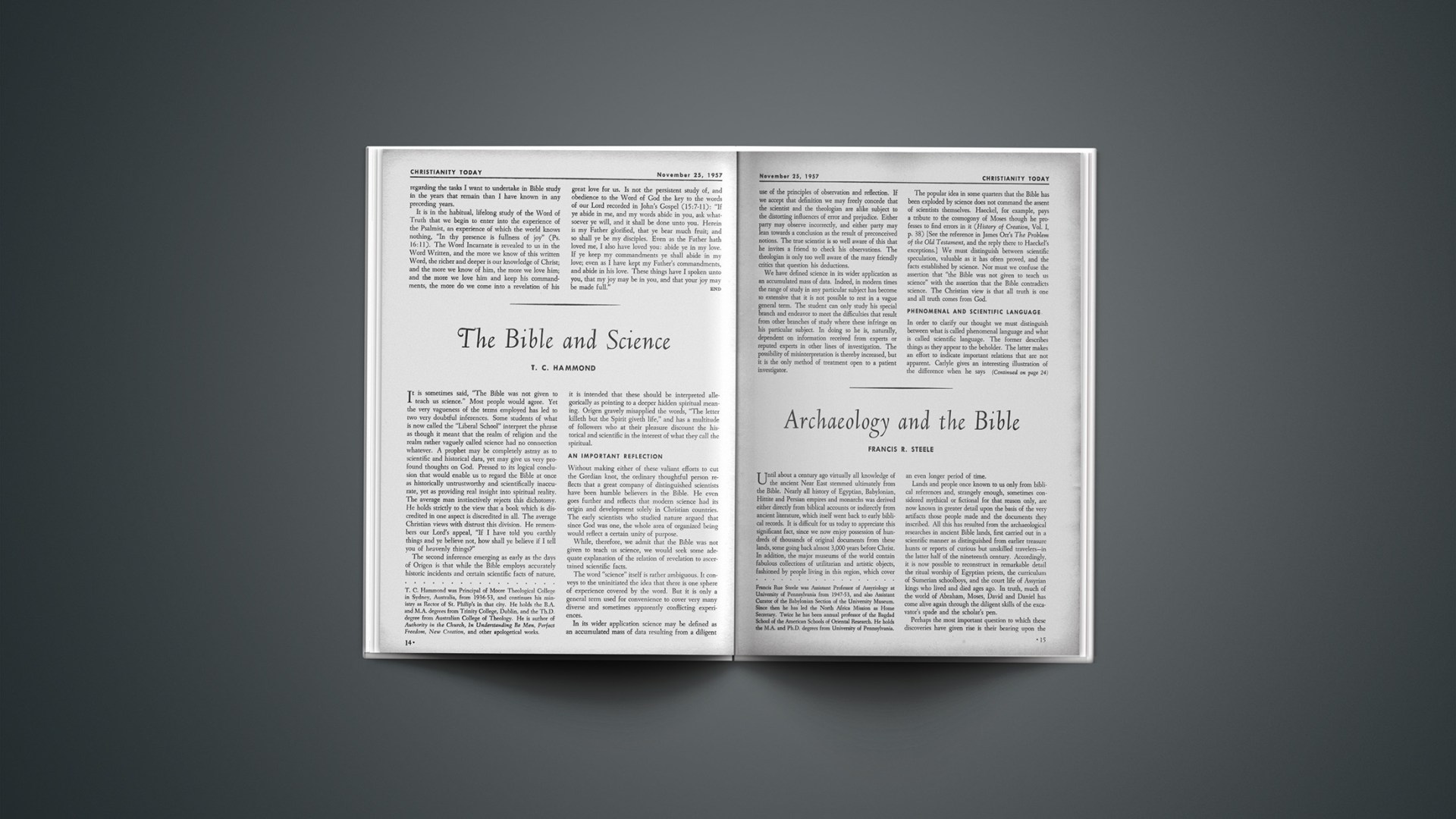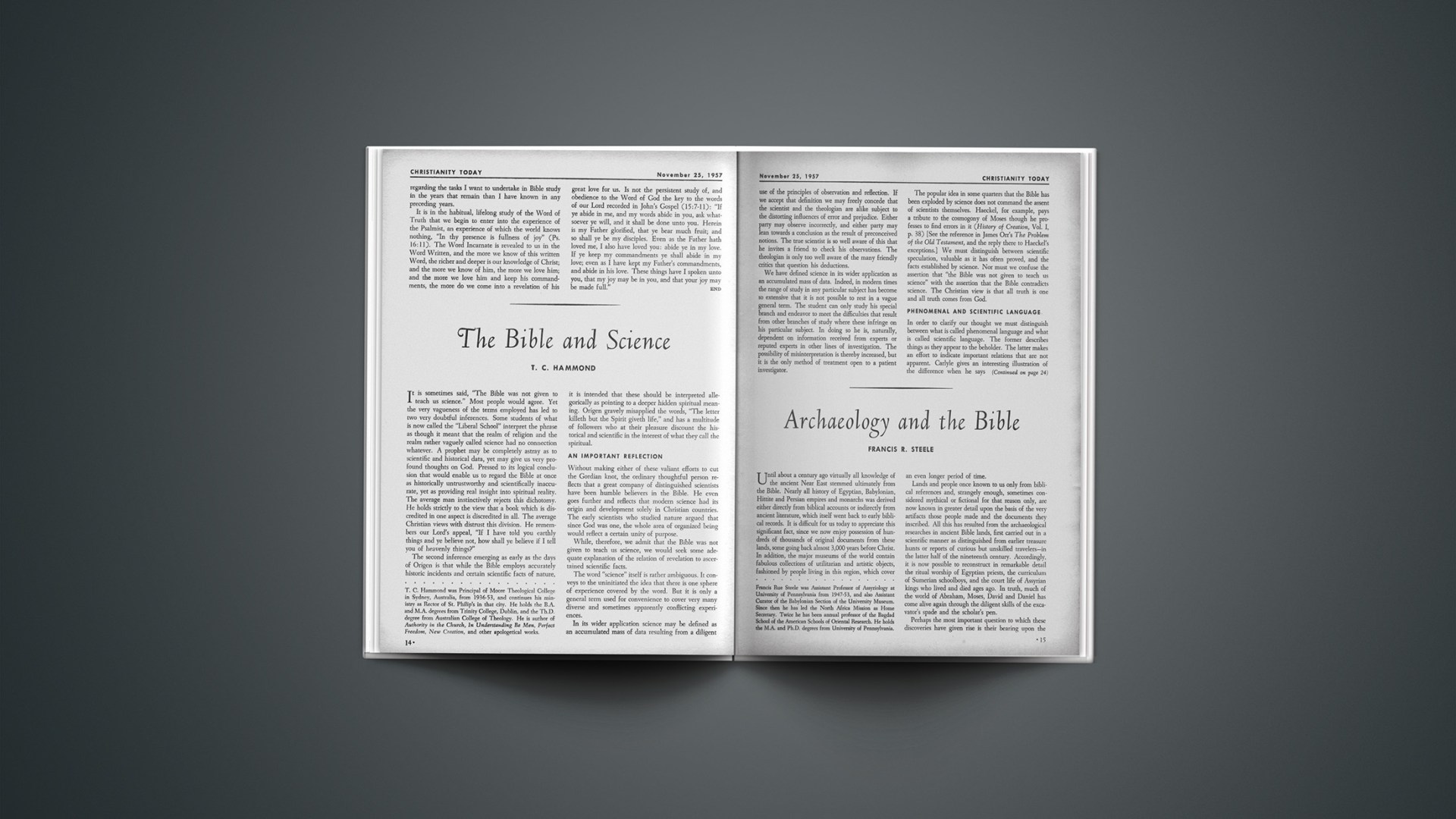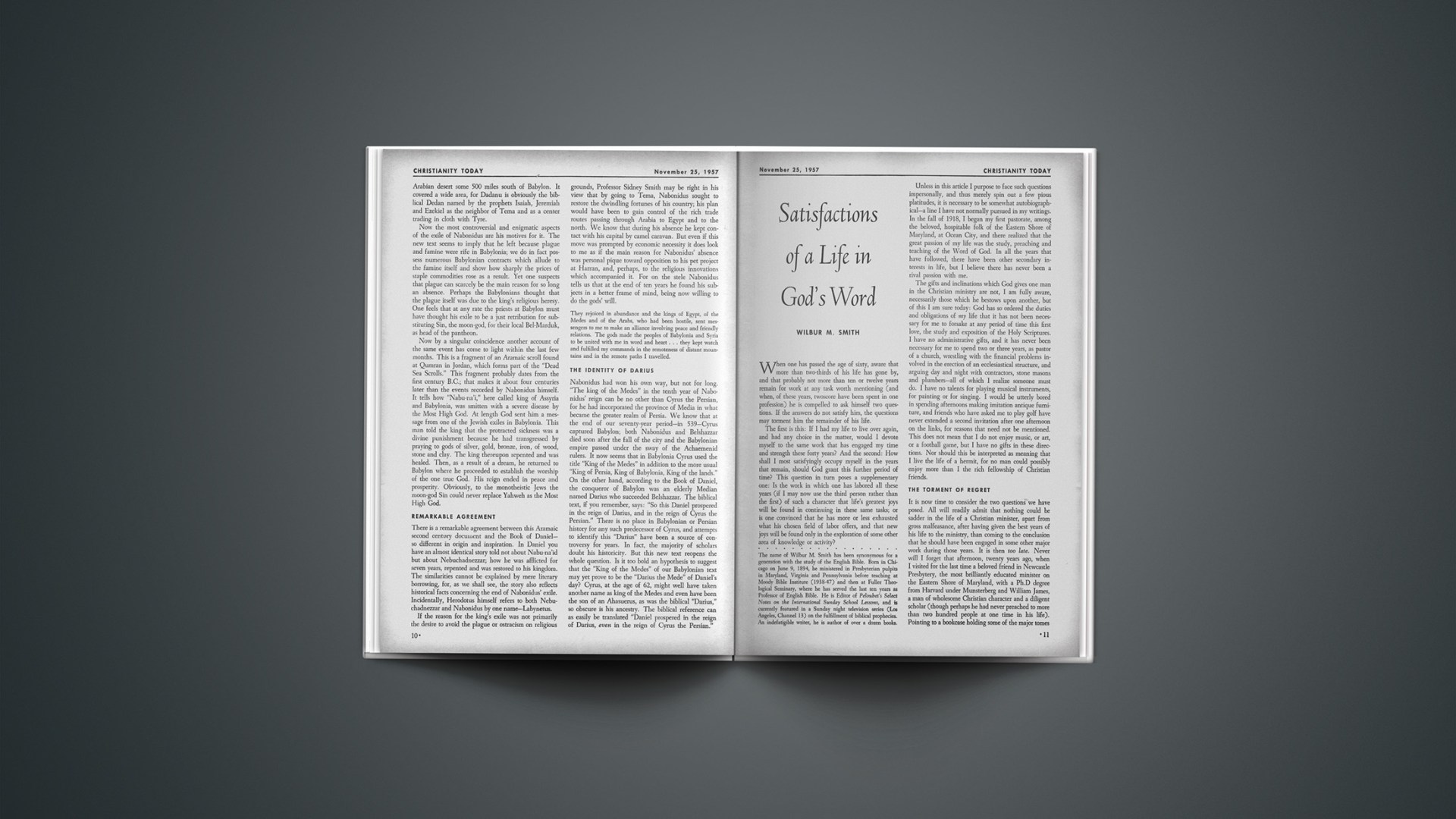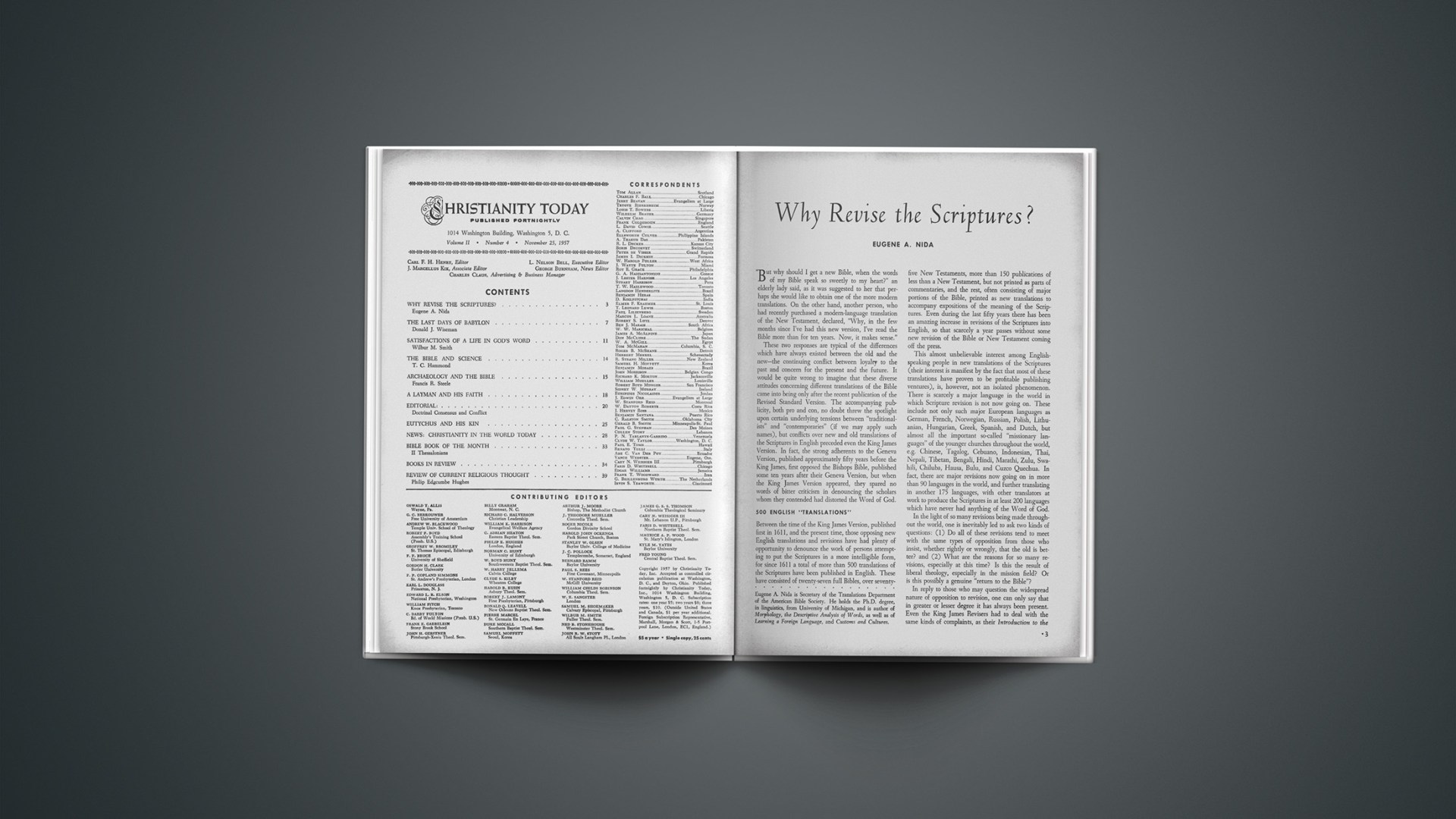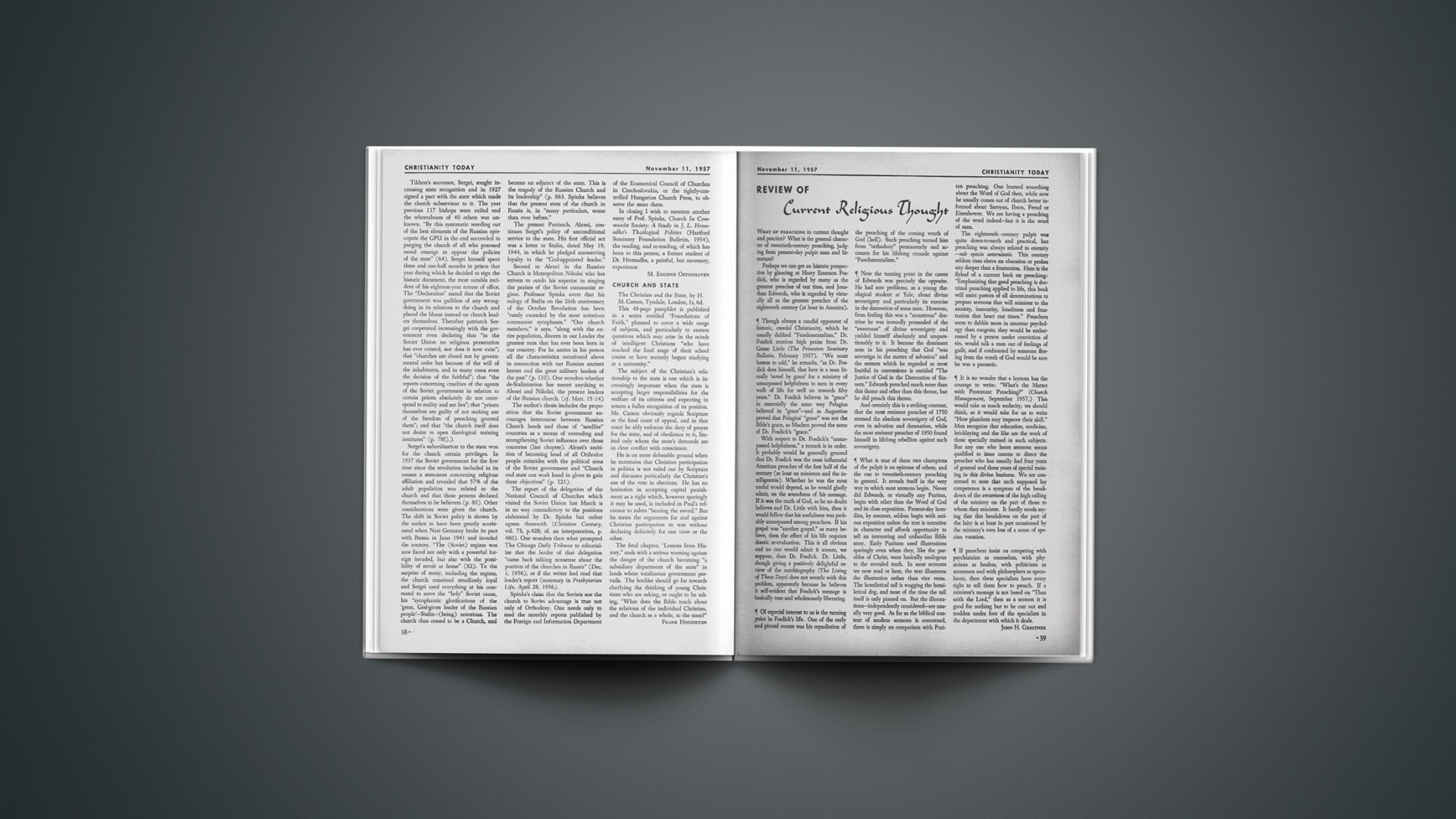Christianity in the World Today
Three prominent clergymen, representing the Jewish, Catholic and Protestant faiths, warned that the evil of communism as it exists today derives from its basic philosophy and not from any distortion of the principles upon which it was founded.
The clergymen, Dr. S. Andhil Fineberg, community-relations consultant of the American Jewish Committee; Bishop Fulton J. Sheen, national director of the Society for the Propagation of the Faith of the Catholic Church, and Dr. Daniel A. Poling, editor of The Christian Herald, made their statements in consultations with the staff of the House Committee on Un-American Activities.
In releasing the statements on “The Ideological Fallacies Of Communism,” Chairman Francis E. Walter declared that they “demonstrate again the basic incompatability of religion with communism in any form.”
“The communist system,” he continued, “is inherently evil for the fundamental reason that it denies the principles of God and morality upon which human society must be founded. As J. Edgar Hoover, director of the Federal Bureau of Investigation has remarked, ‘Those who hate God always bring misery in their wake. They are brutal, cruel and deceitful. Communism denies and destroys every spiritual value. No church and no church member can temporize with it.’ ”
Dr. Fineberg said:
“Lacking a spiritual basis for existence, communist ideologists conceive of people as having no other worthy objective but material prosperity and military might. All other human ideals, hopes, and aspirations are sacrificed for these. And, in pursuit of these goals for the nation as a whole, Communist rulers assume the right to deal with all human beings as though they were the property and chattel of the state. Democratic leaders would never set up one-party government. You will recall that, when the great emancipator Moses was told that several people were speaking against him in the camp, he welcomed that dissent and said, ‘Would that all the people were prophets and that God would put his spirit in all of them.’ ”
In response to the query as to how the forces of freedom can best combat the ideology of communism, he pointed out that the forces of freedom should emphasize the “proof of the superiority of our way of life over life under communism in terms of religious and spiritual values.”
With reference to the relationship between the philosophy of communism and communism in action, Bishop Sheen observed:
“… as in Christianity the word became flesh, or truth became incarnate; in communism the ideology has become action. There is no great diversity between any principles of communism and communism in action. And that is why many people go wrong in judging communism, because they not knowing its ideology, do not understand the present action.
We of the Western World judge Russia by its foreign policy. Whenever there are smiles at Geneva and Russia apparently begins to be lenient with the Western World, we think communism is good. Whereas if you judge it from its ideology, it is a tactic, but not a change of system.”
In regard to the reason for the tremendous inroads made by communism in the course of the last 50 years, Bishop Sheen stated:
“There are many reasons for that. One reason is the spiritual vacuum that has been created in the world. The modern world has lost its faith, it has lost its goal and its purpose. And the world became sick and tired of milk-and-water systems where there was nothing so sacred that you could dedicate your life to it, and nothing so evil that you should risk your life to destroy it. And communism comes into a world that is sick with relativism, and offers an absolute, and men find a loyalty and a dedication and a consecration which gives them great faith in a political system, without imposing any individual morality.”
Among the courses of action which he suggested in undertaking to cope with the international communist menace was the expulsion of Russia from the United Nations, and the insistence by the West on the liberation of certain suppressed peoples.
Dr. Poling stated:
“Communism is a driving dynamic faith. It has all of the passion that we associate with the early Christian church. But its basic tenet, its first principle, is atheism. It not only disregards, but it refutes and denies the Christian ethic. It has absolutely no concern for the individual.”
Dr. Poling pointed out that so-called peaceful coexistence with the Kremlin is both incredible and impossible, that so far as the Kremlin is concerned peaceful coexistence means peaceful submission.
“Communism,” he continued, “has made, in the opinion of some of us, a moral debacle of the United Nations.”
In regard to the manner in which the forces of freedom can compete in the world market place of ideas with communist ideology he said:
“… We need to emphasize not what material things we have here, but the realities of freedom and the fact that communism is slavery. It is the destruction of the very aspirations of the soul. It is enslavement of the body, and you can prove that by pointing to communist slave camps all over the world, and not only the enslavement of the body, but the enslavement of the mind and the soul. And remember one thing; there are more than one billion human beings who believe in one God—the Moslem, the Buddhist, the Roman Catholic, the Protestant, and the Jew.
“We should lay emphasis upon the fact that communism in its first tenet is atheism. We have obscured that idea too often. We need to point to what we have on our coins, ‘In God We Trust.’ We need to get that across, if you please. We are getting the dollar across, but we need to get across the thing that we really finally live by in this country.”
Campus Crusade
Russia, backed by the glamour and prestige of its sputniks, has intensified an offensive aimed at the students of America, not the down-and-outers, according to FBI Director J. Edgar Hoover.
The seriousness of success in such an endeavor can be appreciated by the assertion that less than three per cent of all students played a major role in turning the tide toward communism in Red China.
A similar loud minority is gaining strength in America.
On the other side of the troubling picture is the effective work of Campus Crusade in winning students for Jesus Christ. This effort began in 1951 when a young Los Angeles man named Bill Bright, who had given up a successful business career to labor for Christ, saw the urgent need of presenting the Gospel on the campuses of America. He began at UCLA and 250 students accepted Christ the first year.
The staff of Campus Crusade grew to six during the year and doubled the next. Sixty-seven are now on the staff, with active work on 50 campuses and growing influences at 100 schools.
An ambitious goal for the next 10 years is 1,000 men and women working on campuses throughout the world.
Concerning the need, Bright cited these facts:
“Over three million American and 50,000 International students are studying on 2,500 college campuses all over the United States. However, less than five per cent have any active relationship with the Lord Jesus Christ and his Church.
“Nearly 100 of the first colleges and universities in America, including Harvard, Princeton, Dartmouth, Yale and other well known institutions of higher learning, were established for the express purpose of perpetuating the Christian faith. Yet, today, thousands of students from Christian homes and churches are losing their faith in the Gospel of the Lord Jesus Christ and the Word of God because of the ridicule and antagonism which abounds on the majority of campuses.
“The college campus is the most strategic mission field in the world. There are hundreds of campuses in America and around the world where there is no vital Christian message.”
Members of Campus Crusade, from the beginning, have placed a strong emphasis on the importance of encouraging young Christians to become active in a local church. As a matter of policy, no staff member is allowed to hold a meeting at a time that would compete with regular church services.
End Chapel Services
Weekly chapel services at the University of Vermont will be discontinued, the board of trustees has decided.
Dr. Carl W. Borgmann, president of the state university, said the services would “seem, at least technically, to violate the third article of the Vermont constitution.” He said this article states that “no man ought to, or of a right can be compelled to, attend any religious worship, or erect or support any place of worship.…”
Dr. Borgmann said the worship service might be interpreted as compelling taxpayers to support “a place of worship,” since the university gets a subsidy from the state. He said the weekly chapel service would be discontinued after this semester.
People: Words And Events
Founder’s Week—Moody Bible Institute’s 52nd annual Founder’s Week conference will be held Feb. 3–9, 1958. Featured speakers will be Dr. Wilbur M. Smith, Fuller Theological Seminary, Pasadena, Calif.; Dr. J. Vernon McGee, Church of the Open Door, Los Angeles; the Rev. Theodore Epp, director of “Back to the Bible” Broadcast, Lincoln, Neb. and Dr. Frank C. Torrey, Calvary Independent Church, Lancaster, Pa.
Emporia Gazette—Clergymen affiliated with the Ministerial Association plan to discontinue paid church advertisements in the Emporia Gazette as a result of the paper’s new policy of publishing liquor ads. The Gazette, founded in 1895 by the late William Allen White, ran the first liquor ads in its history on Nov. 1.
Free Bus Service—A free Sunday bus service to and from six downtown Protestant churches in St. Petersburg, Fla., was launched this month on a 20-week trial basis. The service will be provided at cost by the city, with the six churches dividing the charge. Involved in the agreement are Trinity Lutheran, First Presbyterian, First Methodist, Christ Methodist, First Congregational and First Baptist.
Dancing Issue—A resolution urging Baptist leaders to settle “as quickly as possible” the issue of whether dancing should be permitted at denominational colleges in North Carolina was adopted by the state Baptist Student Union at its 28th annual meeting.
Church Growth—The Roman Catholic Church was the only major religious body in New Zealand which grew at a faster rate than the population in the period between 1951 and 1956, government figures disclosed. Roman Catholics increased from 264,555 in 1951 to 310,723 in 1956, a gain of 17.8 per cent. The population increase in the same period was 12.1 per cent. The Church of England in New Zealand is still the country’s largest denomination, claiming over a third of the population. Its membership increased from 726,626 to 780,999, a gain of 7.4 per cent.
Bible Bonanza—Gideons International dedicated 100,000 Bibles at a service in Miami before placing them in more than 500 south Florida hotels and motels. It was the largest number of Bibles ever given away by the organization in a single area at one time. Since 1908, the Gideons have placed more than 35 million Bibles or Scrip ture in hotels, hospitals, jails, motels, trains, ships, airplanes and armed service centers.
Digest—In faculty anniversary celebration at Concordia Seminary, St. Louis, Mo., Dr. John Theodore Mueller observed the 50th anniversary of his ordination, Professor Otto Sohn his 40th and Professor Herbert Bouman and Dr. Gilbert Thiele their 25th.… Dr. R. A. Forrest, who founded Toccoa Falls Bible Institute in 1911, has retired as president. Dr. Julian A. Bandy succeeds him.… Properties rented by churches or associations of churches or businesses acquired by them through the use of borrowed funds will be taxable under a proposal to be made before Congressional committees by the American Bar Association.… For the first time in history, total giving by churches in the United States has passed the two billion dollar mark.… A record 1958 world budget of $26,064,954 for the Seventh-day Adventist Church has been approved by the autumn Council.… Fifty-nine of the Methodist Church’s 102 Conferences in the United States have pledged to give more than $24 million during the next three years to the denomination’s colleges and Wesley Foundations.… The Ford Foundation has approved a grant of $282,000 to Nommensen University in Sumatra. The school was established three years ago by the Batak Church, largest Protestant body in Indonesia.… A group of Spokane, Wash., businessmen have filed an application with the FCC to operate a 50,000-watt commercial station for the promotion of evangelism … Baylor University is seeking $250,000 to establish a Chair on Church and State. It will be named in honor of Dr. Joseph M. Dawson of Austin, a vice president of Protestants and Other Americans United for Separation of Church and State.
Two Questions
In the wake of Little Rock’s racial trouble, the following two questions are asked and answered for CHRISTIANITY TODAY by the Rev. W. O. Vaught Jr., pastor of the Immanuel Baptist Church in Little Rock:
Question—Does the Christian Gospel have an answer to this intricate and involved problem?
Answer—Yes, the Christian Gospel does have an answer, and in my opinion, the only answer. The Christian Gospel teaches that all men are equal in the sight of God and all men must be redeemed by the shed blood of Jesus Christ. The Gospel evaluates man not in the light of the color of his skin or the national or religious background he has had but in the light of his spiritual need. This Gospel lifts man above prejudice and evaluates man on the basis of his innate capacities, his intellectual capabilities and his place in the Kingdom of God.
Our Gospel is based on a premise which Jesus enunciated, that love is stronger than hate. Love put into practice will eventually give a solution to this intricate problem which we now face. Love proclaims equality of opportunity for everybody. Therefore, there is no immediate answer to this staggering problem we now face in this nation. The answer waits on the slow process of the Gospel of Christ gradually changing the minds and hearts of our people. Someone has said, “The ground is level around the cross.” This being true, the closer we get to the cross the more our individual differences vanish.
It has been said, “The mills of God grind slowly, but they grind exceedingly small.” Every Christian in the earth is therefore challenged to re-evaluate his own position as a disciple of love and understanding and good will.
Question—What effect will this crisis have on our world mission program?
Answer—We are now one small world community. What happens in Little Rock, Arkansas, is common knowledge in every nation of the earth through radio and television and newspapers. Can we expect a world to really believe we love them and honestly seek to evangelize them unless we give evidence of love and good will to all our neighbors at home? It may be that there has now dawned our finest hour, or greatest opportunity, our golden era in which to tell all men of all races … “I perceive that God is no respecter of persons.”
The following statement is a report of missionaries from Africa. Read carefully as almost 200 of these missionaries state the case:
“We, the missionaries of the Nigerian Mission of the Foreign Mission Board of the Southern Baptist Convention, have become increasingly aware of the degree to which relationships between the white and Negro races in America determine the effectiveness of carrying out our mission task in Nigeria.
“Nigerians are acutely conscious of the problem of race relations in America. They identify themselves with the American Negro, and they consider racism in any form unjust.
“We believe that racism is inconsistent with, and a hindrance to, the world mission task to which Southern Baptists have committed themselves.
“We sincerely commend Southern Baptist individuals and institutions for the rapid progress made in recent years toward elimination of racism, and for the service they have rendered in meeting the spiritual, educational and social needs of all men.
“We urge all Southern Baptists to work toward the solution of racial problems, realizing that only as these problems are solved can the Great Commission be carried out fully.”
William Penn Bible
The Free Library of Philadelphia has acquired a Bible inscribed by William Penn in 1705 for presentation to his son John, then 5 years old.
The Bible was acquired from the family of the late Judge John M. Patterson of Philadelphia, who bought it at auction in England in 1916. It was given by Penn to the only one of his 13 children born in the new world.
Study Center
Establishment of a study center for research into the Protestant Reformation was initiated recently by a group of scholars meeting at Concordia Theological Seminary in St. Louis.
They met to form the Foundation for Reformation Research, a project backed by a $100,000 fund that includes a grant from the Aid Association for Lutherans. The foundation will collect original documents, microfilm and other secondary sources from continental, English and Scandinavian phases of the Reformation and related periods. These will be housed in a library and research center at Concordia, to be under a full time director.
Members of the foundation’s board of directors are Dr. Roland H. Bainton of Yale University; Dr. Jaroslav J. Pelikan of the University of Chicago’s federated theological faculty; Dr. Theodore Tap-pert of Lutheran Theological Seminary, Philadelphia; Dr. Harold J. Grimm of Indiana University; Dr. Carl S. Myer of Condordia Seminary; and Dr. Ernest G. Schwiehert, command historian for the Air Research and Development Command, Baltimore, Md.
Religion And Science
“There is evidence that religion and science have had a closer association in recent years,” Dr. G. O. Simms, the Protestant Archbishop of Dublin, said recently.
He added:
“There are students of the Bible who pay no attention to the exciting discoveries of archaeology or to the history and background of the Scriptures, but Christian scholars for the most part rejoice to have the aid of the linguist, the archaeologist and the scholarly critic from faculties who can throw light upon the setting and significance of the Bible’s message.
“The basic assumptions of the Christian religion, so far from antagonizing the scientist or frightening him away, are of the kind to inspire him to deeper discoveries and to help him find wholeness and significance in his own specialized field of research.”
—S.W.M.
Latin America
‘A Mortal Sin’
The Puerto Rican Catholic weekly De Reino a Reino (From Kingdom to Kingdom), in discussing the Caribbean Crusade of Dr. Billy Graham, counseled Catholics to abstain from attending meetings “under pain of incurring in a mortal sin.”
Some Catholics were not sympathetic with the statement. A prominent Catholic journalist wrote: “There will be many Catholics, especially among the intellectuals, who will want to find out for themselves if it is true that Billy Graham is indeed a great evangelist, and they will do so, regardless—but that does not mean they will cease to be faithful Catholics of firm conviction.”
In Panama, Monsenor Tomas A. Clavel, Bishop of David, belittled the Crusade. He saw no reason for so much propaganda about that “Protestant pastor who has nothing new to teach us in this country—we Catholics have nothing to learn from them.”
Dr. Graham will tour nine of the Caribbean islands and coastal countries during January and February, climaxing an ambitious program of simultaneous evangelistic campaigns in both the English and Spanish speaking areas. The Graham team will appear at Jamaica, Puerto Rico, Barbados, Trinidad, Venezuela, Panama, Costa Rica, Guatemala and Mexico. R. Kenneth Strachan, general director of the Latin American Mission, will coordinate the effort.
—W.D.R.
Middle East
Stopping Point
Since the airport in Teheran has been developed into a first-class stopping point on international air routes, Iranians have witnessed the arrivals and departures of an astonishing array of churchmen. The largest group were the members of a tour interested in meeting leaders of many nations and of many religions as well as the missionary and national church leadership in each locality.
Of much value to the Church in Iran has been the ministry of Dr. Kenneth Cragg, evangelical scholar in the field of Islamics, whose two-week visit to Anglican and Presbyterian mission areas was only the start of contacts he will continue to develop from his headquarters in Jerusalem. Already his advice in improving the evangelistic approach to Muslims has had an enthusiastic welcome from Iranian and foreign evangelists. Unlike many students of Islam, Dr. Cragg is a missionary who views an understanding of Islam as only the best opening to vigorous evangelism.
Dr. Paul Lindholm, specialist in Christian stewardship and a missionary in the Philippines, initiated a drive for self-support among Iranian Christians during his week of conferences with representatives sent to Teheran for training. His system, based on a thorough exposition of biblical sources, has become the message of a team of missionaries and nationals who will visit churches throughout the coming winter.
Three visitors, all members of the Central Committee of the World Council of Churches, have focused attention toward East Asia: Bishop Lesslie Newbigin of the Church of South India: Dr. Andrew Thakur Das of Lahore, Pakistan, and Bishop Enrique Sobreopena, presiding bishop of the United Church of Christ in the Philippines.
Each had an opportunity to address church leaders, the net effect being that many an Iranian Christian has begun to think of himself as part of a much larger movement and of Asiatic Christians as his brethren in Christ. In the case of Dr. Andrew Thakur Das, who stayed 10 days and led devotional studies from the book of Joshua at the first full meeting of the Presbyterian Mission (previous annual meetings have been delegated), the missionaries and Iranian observers were greatly impressed by the deep spirituality of the man and his testimony to the revival of evangelistic power in West Pakistan. Difficult problems facing the Iranian church and missions seemed smaller as one listened to the story of how the Church of West Pakistan was born out of India’s partition and subsequent persecution of minority groups in both of the new countries.
—F.T.W.
South America
Faith In Liberty
Confident that Colombia’s resurgence of constitutional liberty will be a permanent phenomenon, several missions are undertaking construction programs of varying sizes.
The Cumberland Presbyterian Mission is planning to enlarge its well known “American School” in the city of Cali, moving to an out-of-town site adequate to accommodate 2,000 students.
The Normal School of the Presbyterian Mission (USA) in Ibague is adding three buildings. Other church and mission groups are proceeding with construction plans previously delayed because of the uncertain politico-religious situation.
Optimism is now the order of the day.
Network Expands
The five-member stations of the Pan-American Christian Network, meeting at Station HCJB, Quito, Ecuador, tentatively decided to open membership in the net to other evangelical radio operations, such as recording studios, program chains and local Gospel broadcasts.
Over 30 delegates from a dozen countries attended the conference.
Nearly 4,000 half-hour programs were taped and distributed by the net since its last biennial meeting.
During the next 12 months there is a possibility that as many as five new Gospel stations may be on the air in Latin America.
Network officers for the coming two years will be Robert Remington, manager; W. Dayton Roberts, president, TIFC, Costa Rica; Albert Platt, vice president and treasurer, TGNA, Guatemala; Paul Pretiz, secretary, HOXO, Panama. Other directors are Vern Van Hovel, HCJB, and Ruben Bonney, CP-27, Bolivia.
Far East
Report On Red China
The following special report forCHRISTIANITY TODAYis by Toshio Suekane, General Secretary of the Yokohama, Japan, YMCA, as reported by Kenny Joseph, editor of Japan Harvest, an evangelical quarterly, and director of Evangelism at Japan Christian College, Tokyo.
When I went to China with the 15-man Japanese delegation last spring, I wanted to know what thoughts were uppermost in the Chinese minds. But the answer to this question was difficult to learn, for those who met us were government agents, though representing the so-called church. They were men who approved the current communist setup.
Most of my time was spent in Shanghai, but I also visited Peking, Hankow, Soochow, Canton, Hanchow and Nanking, speaking with people in each place. Some gave us three hours of orientation and all parroted the same thing: “China was victorious so far as the war was concerned, but corruption in government existed from the highest officials down to streetcar conductors. The people’s or general opinion was that only a revolution could overthrow this corruption, but this they naturally dreaded. However, when the communist army first came in, they did not loot or destroy, so they were welcomed.”
With the revolution came the awful innovations of which the people told me. The communist party set groups and instigated “study classes for self-criticism” if there was opposition. It was actually “brain washing.” It is still in progress. Anti-revolutionists were quickly liquidated. Suicides occurred in such large numbers that it was dangerous to walk near high buildings. Mao Tse Tung admitted 800,000 “liquidated,” exclusive of suicides. Reports varied, however, for Hongkong heard it was 4,000,000 and Formosa, 12,000,000.
I went to a penitentiary and asked the head man how many lives were sacrificed in the revolution. He made no reply. The terror of those days was so strong that it still showed on those with whom I talked. Once a friend at the hotel where I stayed told me what certain Christians did. Then he said, “God knows—let’s not talk about it.” After this he bowed his head on my knees and cried, and together we prayed for 30 minutes.
In the country, the landowners’ property was confiscated and portioned out to those doing the farming. During a “Peoples’ Court,” crimes dating three generations back were retold and the present landowners punished. Some would confess and hand over all they had, but even this wasn’t satisfactory and they were still condemned to death. In 1949 and 1950 there were only 3,000,000 communists, and others became fellow travelers. I was told that the intelligensia didn’t approve of communism, but they thought it was the only expedient way out for the nation.
You have heard that there are no flies, no dogs, no cats (which would all be a burden to the people to care for, so they were eaten as food because of economic necessity) and no prostitutes. Externally this may be true. The situation is changed from what it was 11 years ago. But people clearly show their heartache. Only teenagers laugh freely. The older folk are very serious and stern, not lighthearted. This is true even among Christians. They are all politicians, concerned with the government—that’s all you hear.
Needs are very real; sugar and white flour are impossible to get. Students are often in near rags, just like the Japanese immediately after the war. Even underwear cannot be bought without a ration card. Most people must walk, and though there are buses, one must wait in line a long time.
Cooperative farming was to be set up, but the promised machinery hasn’t come. Increase in products was also promised, but no results. Hence there is dissatisfaction. People are told to express their opinion, but they do not dare. Discontent is rampant everywhere. To combat this the Reds instituted a “Rectification” campaign. One man said that merely means another “bloody purge,” and that feeling is evident everywhere. Students opposition is handled by having two governing bodies; one communist and the other of college representatives. Control is in the hands of the communist members. A man in Shanghai said, “I threw my pen away—couldn’t do any writing anyway.”
I have read of the arrests which took place in July after the “rectification” campaign and I am afraid many of my friends may have been arrested.
The Christians in Canton made public this pledge they are bound to:
1. We will guard and defend
A. Chairman Mao Tse Tung
B. Communism
C. The government
D. The liberation army and
E. The constitution
2. We will enthusiastically take part in loving our country and study communist policies of the government.
3. We will support the 3-self movement.
4. We will cut all connections with imperialism.
5. We will help one another.
6. We will obey Christ’s command to love one another.
7. We will love man and society.
8. On Sunday we will go to church to worship.
‘Mighty Promise’
The 1957 Worldwide Bible Reading observance, planned for the period from Thanksgiving to Christmas, has been hailed by President Eisenhower as holding “a mighty promise” for mankind.
“As the Bible’s message is made available in 1,100 tongues, reaching into the most distant corners of the earth,” the President said, “we are given strength to continue our work toward that greatest objective of all: peace on earth, good will to men.”
During the designated period, people all over the world read a preselected Scriptural passage on the same day. Last year persons in more than 50 countries participated. Climax of the program is Universal Bible Sunday, a tradition in this country since 1904, which falls on December 8.
This was signed November 4, 1951, and was put in all the churches in China. There is a clause in the constitution guaranteeing religious freedom, but nothing “anti-revolutionary” is tolerated. Not only is there freedom of religion, but also freedom of non-religion or official atheism, therefore no public proclamations (such as street meetings) can be held. It is very hard to know what is “anti-revolutionary” and what is not. Wang Min Tao, a famous Peking evangelist, was strong in his evangelical position and refused to enter into the forced union of churches. He was arrested, but the propaganda says it was not because of his Christian faith, rather because of “political” reasons.
The “Sanjiai” (3 self—self-governing, supporting, propagating) movement is an official government-approved patriotic association and has 60 per cent of the Christians enrolled. This group invited us to China. Younger men comprise the group, older men are figureheads only. They took possession of the NCC building. Episcopalians and Baptists are mostly in the leadership. The Student YMCA is not in existence. There is no real advance in the churches; the buildings have been confiscated and not returned. The time may soon come when there will be a great deal of suffering. My own fear is that the churches will collapse. Young people in the churches are few.
I have received many letters criticizing me severely. The “China-Japan Cultural Association” is seemingly neutral, yet there the infiltration of communism cannot be denied. Many groups are being infiltrated in Japan; this brings to mind how the students rioted because they couldn’t attend the Moscow convention. Some 150 did go and they returned praising Russia’s “peaceful H-Bomb and denouncing Britain’s and America’s “war” H-bomb, as the Chinese did. In the educational world, Nikkyo (the Japan Teacher’s Union) is still influential in sending the communist belief all over Japan.
In China, society is thoroughly communized, but the church could do little about it. Japan today faces the same issues. Here the student communist federation is working to produce leaders for the communist party. We must fight now to retain our freedom. It is a precious thing. My fountain pen was stolen twice in Hongkong, yet I still prefer this harbor city to oppressed Red China, though I could lay it down anywhere in China without being stolen. Freedom is much more precious than a fountain pen!
The Big Secret
What is the secret of the phenomenal rise of the Korean Church?
Some say Bible study. Some say self-support. Others say it is insistence on personal witness by believers. All probably are true, but many believe that the real secret is the intense prayer life of the Korean Church.
An American elder said to a Korean pastor a few months ago, “How many do you get out to your prayer meetings?”
“About 80,” replied the pastor.
“Why, you are no farther along than we are,” said the visitor. “We get that many out ourselves back in California on Wednesday evenings.”
“Oh,” said the surprised Korean, “if you are talking of the Wednesday night service, we get 800 out for that. I thought you meant our daily dawn prayer meetings. About 80 of our people come at 5 o’clock every morning to pray.”
That is characteristic of the Korean churches everywhere, in the city as well as the country, and where there is such prayer there is power.
—S.H.M.



